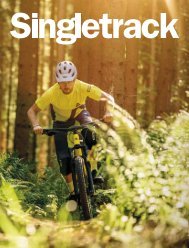Create successful ePaper yourself
Turn your PDF publications into a flip-book with our unique Google optimized e-Paper software.
gear review by <strong>Climber</strong> Test Team<br />
Sleep<br />
Light<br />
Lightweight<br />
Camping &<br />
Bivvy Gear<br />
Heading to climb in remote areas or mountain crags and want to<br />
keep weight down? We look at lightweight options for nights out.<br />
There are times when you want to climb in the mountains for two or three days (or longer), for<br />
example, on Scafell or Ben Nevis, but can’t face the long slog each day. So the alternative is to<br />
bed down close to the crag. The problem with this is the amount of weight you’ll be carrying,<br />
hauling a trad rack, ropes, food, water, etc is bad enough. Then factor in gear you need to<br />
spend a comfortable night and suddenly the weight of your already heavy pack starts to sink in<br />
and the appeal of camping diminishes.<br />
These days new materials and techniques have shaved considerable amounts of weight from<br />
what you need, especially on the basics: sleeping bag, tent and sleeping mats. Most of this stems<br />
from the development of kit used by elite athletes taking part in mountain marathons where every<br />
gram counts. So we looked at some of the kind of kit available for a two to three season camp or<br />
bivvy in far-to-reach places and mountains to help you keep weight down and still maintain comfort.<br />
Alpkit Hunka<br />
Bivvy Bags<br />
Sometimes you may only be out for a night, or<br />
are planning an Alpine route where you may be<br />
on a ledge mid-route and using a tent isn’t<br />
practical. This is where a bivvy bag comes in to<br />
protect you from the elements.<br />
Alpkit Hunka bivvy bag<br />
Weight: 360g RRP £47<br />
The Hunka is a simple and affordable bivvy bag<br />
that is waterproof and breathable. It is commonly<br />
found near the top of a lot of climbers’ wish list, in<br />
fact visit Alpkit’s web site and you’ll likely find it out<br />
of stock such is the demand. So, why is it popular?<br />
It is manufactured from thin ripstop nylon<br />
and weighs in at around 360g. The thin material<br />
doesn’t feel as durable as some others on the<br />
market, but then the more durable bags are<br />
usually heavier. It achieves this weight in no<br />
small part by not having a zip, which does make<br />
it trickier to get into and out of, especially if you<br />
are using a thicker sleeping bag and/or have your<br />
mat in there too. But the benefit of going zip-less<br />
is that it does massively help to keep rain out.<br />
The hood is roomy enough to stuff a dry bag<br />
with some clothes in to act as a pillow which<br />
helps with a good night’s sleep. There are two<br />
drawstrings, one across the chest and the other<br />
in the hood, to seal out the elements, and a cinch<br />
toggle on either side of the hood by your ears.<br />
The drawstrings can get in your face a little<br />
during the night and are a mild annoyance.<br />
In terms of breathability, be careful to not seal the<br />
drawstrings too tightly, otherwise you get a bit of<br />
dampness inside, but that applies to other bivvy<br />
bags, even those double the price. The Hunka<br />
packs down into a neat net stuff sack built into<br />
the foot of the bag, and when packed isn’t much<br />
bigger than a lightweight hardshell jacket.<br />
It comes in a choice of three colours, and an<br />
XL is available if you are tall or want to stuff your<br />
gear in with you. It is recommended for three<br />
season UK and summer Alpine trips. It’s light and<br />
small enough that you won’t mind tossing it into<br />
your pack as a ‘just in case’ item and at the price<br />
it’s a great value product.<br />
MSR E-Bivy bag<br />
Weight: 236g RRP £105<br />
This truly ultra-light, compact and weather<br />
resistant bivvy bag offers the ultimate in minimalist<br />
bivvying. The fabric used is 30D silicone coated<br />
ripstop nylon for the top and tougher more durable<br />
30D Durashield coated nylon for the base that<br />
provides a higher degree of waterproofness.<br />
You should be fully aware that it isn’t fully<br />
waterproof with no taped or sealed seams but<br />
can deal with light showers and morning dew In<br />
heavier rain it should be combined with a sleeping<br />
bag with hydrophobic down filling designed to keep<br />
the down dry and a tarp. Though if you want to be<br />
out in fouler weather then you should look at fully<br />
waterproof options. The base offers more water<br />
resistance and keeps you dry from damp ground<br />
with no problem. There is no zip at the entrance<br />
with just a simple opening but the entrance is big<br />
enough to make it relatively easy to get in.<br />
The breathability of the bag was found to be<br />
okay with little in the way of condensation and<br />
dampness on the inside of the bag and it also<br />
keeps the wind out. It was spacious enough to<br />
take a sleeping bag complete with mat with ease.<br />
It also makes a good ‘cover’ for a sleeping bag,<br />
adding to the warmth and durability if the outer<br />
shell is particularly lightweight. Given the miniscule<br />
weight and tiny pack size you can always leave it<br />
in your pack for use as emergency protection.<br />
MSR E-Bivy<br />
68 Sep–Oct <strong>2017</strong> www.climber.co.uk






